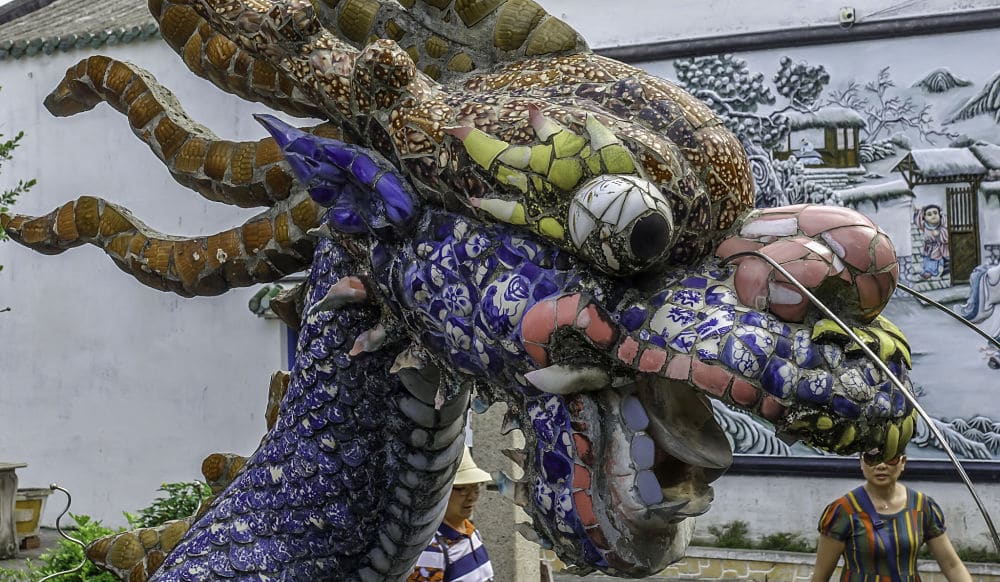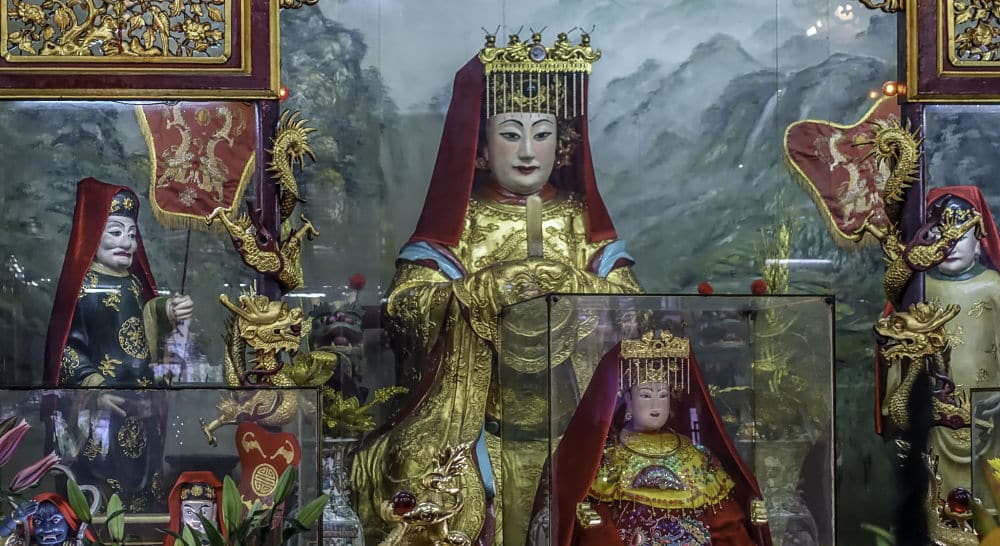The History
Updated July 2022
As Chinese merchants and traders morphed into settlers in the 1700s, they began constructing Chinese Assembly Halls and temples where they could congregate, worship and preserve age-old traditions. A prominent trading hub from the 1500s to the 1800s, Hoi An still hosts 5 Chinese Assembly Halls, all constructed on Tran Phu (or its extension, Nguyen Duy Hieu), facing the water.
The earliest of these was Hoa Van Le Nghia in 1741 and the most recent Quang Trieu, the Cantonese Assembly Hall, in 1885.
Hoi An is still home to a sizable ethnic Chinese community many of whom are descendants from merchants and traders from Hoi An’s heyday, when it was arguably the most important port in SE Asia and the end of the Silk Road. For them and visiting pilgrims, Hoi An’s Chinese Assembly Halls are still sites of religious importance, especially ancestor worship.
How to Visit
There are ticket offices with English-speaking staff at all of the major entryways to Hoi An Ancient Town. Five passes to historic sites come as a batch along with a small map for 120,000VND (children under 15 free) and guarantee Old Town access for the rest of your stay. But if you want to visit more than 5 sites you’ll need to buy extra tickets. Immediately after Covid-19 prices were halved but will return to the standard 120,000VND 1 January 2023.

Hoa Van Le Nghia
Free to enter, this complex, dating back to 1741, is the oldest in this list. It was both a meeting place and a place of worship for the Hoi An-based Chinese communities.
It is dedicated to the goddess Thien Hau, a version of the Chinese sea goddess Mazu – goddess of fortune, especially for seafarers. Mazuism is a faith popular in the southern maritime provinces of China that is often combined with Taoism and Buddhism.
Add: 64 Tran Phu

Phuoc Kien (Fujian) Assembly Hall
A simple thatched Vietnamese pagoda built in 1692 gave way in 1759 to a meeting place and impressive temple for rich Fujian merchants – the dominant Chinese group at the time. For traders and immigrants from this southern, coastal Chinese province, Sea goddess Thien Hau is the focus but lesser gods and goddesses who can see and hear ships from afar are also featured.
Popular, Chinese Gods, often associated with fortune, wealth and the open seas, are prominent, as are Fujian-born Generals from the Ming Dynasty. Important animals symbolic of noble qualities in Chinese culture – dragon for power, unicorn for knowledge, turtle for endurance and so on are also scattered throughout the complex.
As with most Chinese assembly halls 16 January (lunar) is a key date and an auspicious one.
Add: 46 Tran Phu
Hai Nam Assembly Hall
Built in 1875 to honour 108 Chinese merchants, who were unjustly killed, because they were mistaken for pirates. Later they were cleared of the charge and named “deities” by King Tu Duc, who granted money to build this assembly hall to make amends by enabling their worship in perpetuity.
Like most assembly halls, Hai Nam was built in the Chinese style, consisting of the main worship chamber, the east house, the west house, the front courtyard and the back courtyard.
Add: 10 Tran Phu
Trieu Chau Assembly Hall
Built in 1845 Trieu Chau Assembly Hall is dedicated to General Phuc Ba (Bon Dau Quan), a god of mastering waters. The two sides of Phuc Ba’s altar are refined for worshipping the Gods of Wealth and Luck.
The east-wing house is dedicated to former sages, chiefs and deputy-chiefs of the house.
Every year, descendants of the Trieu Chau people gather at the house from the 1st to the 16th of January (lunar) to worship their ancestors.
Add: 362 Nguyen Duy Hieu
Quang Trieu ‘Cantonese’ Meeting Hall
Constructed in 1885 by Cantonese (Guandong) traders and seafarers originally to honour the Goddess Thien Hau, as is common among many of the Chinese Meeting Hall/Temples.
Later it became a Quon Cong temple for Chinese immigrants with a focus on ancestor worship. Quon Cong was a prominent mandarin of the Han Dynasty (3rd century AD) – a symbol of courage, loyalty and piety.
Finally, the hall honours the Cantonese sages who travelled to Hoi An in the past.
An annual festival takes place 16 January (lunar) with a focus on ancestor worship.
Add: 176 Tran Phu
Hoi An Timeline
Before 1500
Contemporary Hoi An area was part of the deeply spiritual Hindu Champa Kingdom, known as Lam Ap. Many Champa relics and buildings can be found in the area.
1500s
Japanese traders begin to arrive, followed by the Chinese. The famous Japanese Covered Bridge was constructed in 1593 to link the Japanese quarter with the Chinese quarter. Name was changed to Hoi An and a trading port is formally established by a Nguyen lord in 1595.
1600s
Ruled by the Nguyen Lords who fostered trade and encouraged visitors from Japan, China and other Eastern Asian regions to leave agents behind. First Japanese, then Chinese merchants came to trade, later Japanese and Chinese settlers gathered in Hoi An. Known in this period as Hoi An Pho (peaceful meeting place) which was contracted to Hoi Pho (Seaside Town). This in turn morphed into Faifo for European traders.
New Japanese laws forbidding settlement of Japanese people outside Japan during the 1630s limited newcomers. The Chinese gradually became the dominant foreign group in Hoi An, especially from Fujian Province.
Early 1700s
Chinese trade and settlement continued to prosper. Hoi An developed into the most significant Chinese settlement in Vietnam. The first Chinese Assembly Halls were built mid-1700s including the majestic Fujian Assembly Hall.
Late 1700s
Hoi An was attacked by Trinh Lords at the time of the Tay Son Rebellion. Many buildings, including many Japanese houses, were destroyed. This is the key reason why few Japanese buildings remain in the present day.
Early 1800s
The triumph of Emperor Gia Long – after the Tay Son rebellion – saw the French repaid for their assistance with exclusive rights to Da Nang. This combined with the silting up of Hoi An’s Thu Bon River saw Hoi An exit the international stage. Established Chinese communities in Hoi An continued to thrive however, and Hoi An’s quaint charm is preserved.
After 1858
The French invaded Vietnam, including Hoi An and brought it under their control. Many colorful French colonial buildings remain to this day, reflective of a period that lasted almost 100 years until the French were ousted in 1954. The last of the Chinese Assembly Halls – Cantonese – was built in 1885.
1900s
The rail link between Hoi An and Da Nang was destroyed in 1916 and never rebuilt. The beautiful backwater town of Hoi An was spared the heaviest conflicts by agreement on all sides during the 20th century wars.
Current Era
In 1999 Hoi An was granted world heritage status and, with its beautifully preserved Old Town, became one of the most sought-after tourist destinations in Asia. In 2017 3.2 million tourists visited Hoi An.
